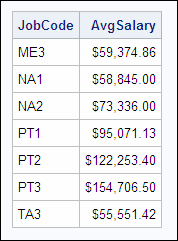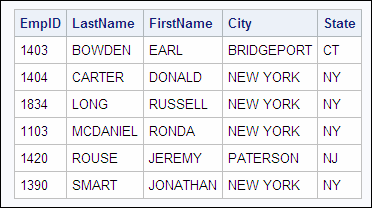Subsetting Data By Using Noncorrelated Subqueries
A noncorrelated subquery is a self-contained subquery
that executes independently of the outer query.
Using Single-Value Noncorrelated Subqueries
The simplest type of subquery is a noncorrelated subquery
that returns a single value.
The following PROC SQL
query is the same query that is used in the previous section. This
query displays job codes for which the group's average salary
exceeds the company's average salary. The HAVING clause contains
a noncorrelated subquery.
proc sql;
select jobcode,
avg(salary) as AvgSalary
format=dollar11.2
from sasuser.payrollmaster
group by jobcode
having avg(salary) >
(select avg(salary)
from sasuser.payrollmaster);PROC SQL always evaluates
a noncorrelated subquery before the outer query. If a query contains
noncorrelated subqueries at more than one level, PROC SQL evaluates
the innermost subquery first and works outward, evaluating the outermost
query last.
In the query shown above,
the inner query and outer query are processed as follows:
The query output is
shown here.
This noncorrelated subquery
returns only a single value, the average salary for the whole company,
to the outer query. Both the subquery query and the outer query use
the same table as a source.
Using Multiple-Value Noncorrelated Subqueries
Some subqueries are multiple-value subqueries: they
return more than one value (row) to the outer query. If your noncorrelated
subquery might return a value for more than one row, be sure to use
one of the following operators in the WHERE or HAVING clause that
can handle multiple values:
-
the conditional operator IN
-
a comparison operator that is modified by ANY or ALL
-
the conditional operator EXISTS.
CAUTION:
If you create a noncorrelated
subquery that returns multiple values, but the WHERE or HAVING clause
in the outer query contains an operator other than one of the operators
that are specified above, the query fails. An error message is displayed
in the SAS log, which indicates that the subquery evaluated to more
than one row. For example, if you use the equal (=) operator with
a noncorrelated subquery that returns multiple values, the query fails.
The equal operator can handle only a single value.
Consider a query that
contains both the conditional operator IN and a noncorrelated subquery
that returns multiple values. (The operators ANY, ALL, and EXISTS
are presented later in this chapter.)
Example
Suppose you want to
send birthday cards to employees who have birthdays coming up. You
decide to create a PROC SQL query that lists the names and addresses
of all employees who have birthdays in February. This query, unlike
the one shown on the previous page, selects data from two different
tables:
-
employee names and addresses in the table Sasuser.Staffmaster
-
employee birthdates in the table Sasuser.Payrollmaster.
In both tables, the
employees are identified by their employee identification number (EmpID).
In the following PROC
SQL query, the WHERE clause contains the conditional operator IN followed
by a noncorrelated subquery:
proc sql;
select empid, lastname, firstname,
city, state
from sasuser.staffmaster
where empid in
(select empid
from sasuser.payrollmaster
where month(dateofbirth)=2);This query is processed
as follows:
The output, shown below,
lists the six employees who have February birthdays.
Although an inner join
would have generated the same results, it is better to use a subquery
in this example since no columns from the sasuser.payrollmaster table
were in the output.
Using Comparisons with Subqueries
Sometimes
it is helpful to compare a value with a set of values returned by
a subquery. When a subquery might return multiple values, you must
use one of the conditional operators ANY or ALL to modify a comparison
operator in the WHERE or HAVING clause immediately before the subquery.
For example, the following WHERE clause contains the less than (<)
comparison operator and the conditional operator ANY:
where dateofbirth < any <subquery...>
CAUTION:
If you create a noncorrelated
subquery that returns multiple values, and if the WHERE or HAVING
clause in the outer query contains a comparison operator that is not
modified by ANY or ALL, the query fails.
When the outer query
contains a comparison operator that is modified by ANY or ALL, the
outer query compares each value that it retrieves against the value(s)
returned by the subquery. All values for which the comparison is true
are then included in the query output. If ANY is specified, then the
comparison is true if it is true for any one of the values that are
returned by the subquery. If ALL is specified, then the comparison
is true only if it is true for all values that are returned by the
subquery.
Note: The operators ANY and ALL
can be used with correlated subqueries, but they are usually used
only with noncorrelated subqueries.
Consider how the operators
ANY or ALL are used.
Using the ANY Operator
An outer query that specifies the ANY
operator selects values that pass the comparison test with any of
the values that are returned by the subquery.
For example, suppose
you have an outer query containing the following WHERE clause:
where dateofbirth < any <subquery...>
This WHERE clause specifies
that DateofBirth (the operand) should be less than any (the comparison
operator) of the values returned by the subquery.
The following chart
shows the effect of using ANY with these common comparison operators:
greater than (>), less than (<)
and equal to (=).
|
Comparison Operator
with ANY
|
Outer Query Selects...
|
Example
|
|---|---|---|
|
> ANY
|
values that are greater
than any value returned by the subquery
|
If the subquery returns
the values 20, 30, 40, then the outer query selects all values that
are > 20 (the lowest value that was returned by the subquery).
|
|
< ANY
|
values that are less
than any value returned by the subquery
|
If the subquery returns
the values 20, 30, 40, then the outer query selects all values that
are < 40 (the highest value that was returned by the subquery).
|
|
= ANY
|
values that are equal
to any value returned by the subquery
|
If the subquery returns
the values 20, 30, 40, the outer query selects all values that are
= 20 or = 30 or = 40.
|
Tip
Instead of using the ANY
operator with a subquery, there are some SAS functions that you can
use to achieve the same result with greater efficiency. Instead of
> ANY, use the MIN function in the subquery. Instead of < ANY,
use the MAX function in the subquery.
Example
Suppose you want to
identify any flight attendants at level 1 or level 2 who are older
than any of the flight attendants at level 3. Job type and level are
identified in JobCode; each flight attendant has the job code FA1,
FA2, or FA3. The following PROC SQL query accomplishes this task by
using a subquery and the ANY operator:
proc sql;
select empid, jobcode, dateofbirth
from sasuser.payrollmaster
where jobcode in ('FA1','FA2')
and dateofbirth < any
(select dateofbirth
from sasuser.payrollmaster
where jobcode='FA3'),Here is what happens
when this query is processed:
Note that both the outer
query and subquery use the same table.
Note: Internally, SAS represents
a date value as the number of days from January 1, 1960, to the given
date. For example, the SAS date for 17 October 1991 is 11612. Representing
dates as the number of days from a reference date makes it easy for
the computer to store them and perform calendar calculations. These
numbers are not meaningful to users, however, so several formats are
available for displaying dates and datetime values in most of the
commonly used notations.
Below are the query
results.
Tip
Using the ANY operator to
solve this problem results in a large number of calculations, which
increases processing time. For this example, it would be more efficient
to use the MAX function in the subquery. The alternative WHERE clause
follows: where jobcode in ('FA1','FA2')
and dateofbirth <
(select max(dateofbirth)
from [...]For more information
about the MAX function, see the SAS documentation.
Using the ALL Operator
Example
Substitute ALL for
ANY in the previous query example. The following query identifies
level-1 and level-2 flight attendants who are older than all of the
level-3 flight attendants:
proc sql;
select empid, jobcode, dateofbirth
from sasuser.payrollmaster
where jobcode in ('FA1','FA2')
and dateofbirth < all
(select dateofbirth
from sasuser.payrollmaster
where jobcode='FA3'),Here is what happens
when this query is processed:
The query results, below,
show that only two level-1 or level-2 flight attendants are older
than all of the level-3 flight attendants.
Tip
For this example, it would
be more efficient to solve this problem using the MIN function in
the subquery instead of the ALL operator. The alternative WHERE clause
follows: where jobcode in ('FA1','FA2')
and dateofbirth <
(select min(dateofbirth)
from [...]For more information
about the MIN function, see the SAS documentation.
..................Content has been hidden....................
You can't read the all page of ebook, please click here login for view all page.




